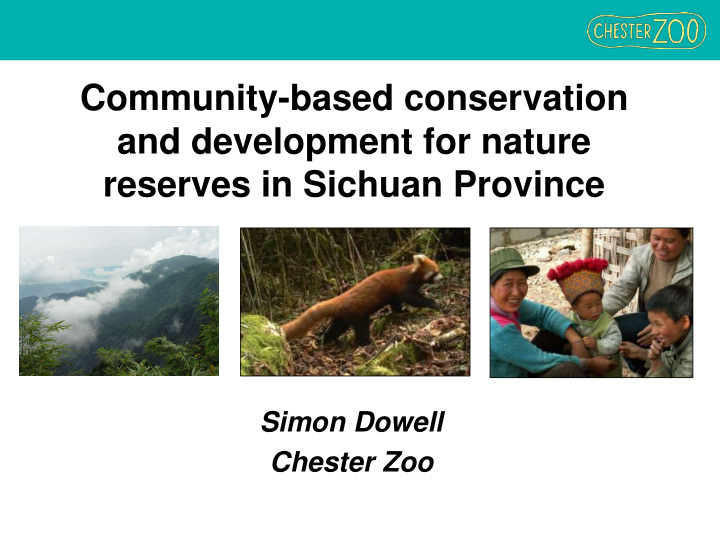



Community-based conservation and development for nature reserves in Sichuan Province Simon Dowell Chester Zoo
Galliforme Action Plans Sichuan Hill-partridge Arborophila rufipectus (IUCN red list status at the time: CR)
Range of the Sichuan Hill-partridge in the Liang Shan region of Sichuan Province Liang Shan Beijing China Shanghai Hong Kong
Biodiversity Hotspots Mountains of Southwest China Liang Shan
Photo: Lin Zhi Photo: Lin Zhi Photo: Lin Zhi
Giant panda in the Liang Shan Liang Shan Source: assets.panda.org
1998 – Yangtze Floods and Logging Ban
Liang Shan – new protected area network QINGCAIPING
Sichuan Forest Biodiversity Project Goal: Sustainable populations of endemic species in an effectively protected forest network.
Threats
Capacity Building
Liv ivelihood ihoods
Bio iogas gas St Stove oves s - Laoj aojuns unshan han • 31 biogas stoves installed • Targeted in NE edge of reserve where disturbance is greatest • Reduce firewood collection by up to 85% • Recipients sign a ‘no forest disturbance’ agreement • Link with education work – summer school • Effectiveness now reduced as villages modernise
Community Support - Mamize
Bee Keeping - Heizhugou • Initially village leaders targeted – influence on rest of community • Match funds from local Government allows whole village approach • Yield and income from honey builds with time • Families switch from collecting forest products to full-time bee-keeping • Reduces insecticide use on local crops
Schools Project
How do we know it is working? Wildlife Monitoring - Transects
Galliformes Monitoring Population density estimates of territorial males for five Galliforme species, Laojunshan National Nature Reserve, 2008 - 2016 Calling males per km2
Research on the Sichuan Hill-partridge
Camera Tra rappi ping ng
Camera trap grid
Working rking with th di diff fferent erent au autho horities rities QING CAI PING
Annual Nature Reserves Conference • Delegates from all five supported reserves • Detailed presentations and discussion of monitoring and management work • Agreements on standard methodology for monitoring work
Wha hat ha have ve we we le learnt arnt? • Species approach can provide effective focus for wider habitat protection • Capacity building of nature reserve teams important element of reserve development • Emphasis on community development but improved project design needed to ensure their sustainability • Effective mechanisms for monitoring & evaluation can be hard to achieve on the ground Conservation Impact • Some evidence of wildlife population recovery from Galliformes monitoring, camera trapping and species research • National Nature Reserve status achieved for Laojunshan (2010) and Heizhugou (2011)
Ac Acknowle nowledgeme dgement nts Sichua huan n Forest t Departm artment ent Local cal Forestry try Bureaus us (Pingsha gshan, , Leibo bo, , E’bian , , Ganluo luo, , Meigu) Laojunshan junshan, , Mamiz ize, , Heizhug hugou, , Ma’Anshan & & Qingcai gcaiping ping Nature ture Reserves ves Acade demia mia Sinica ica, , Institute titute of Zoology gy – Prof He Fen-qi qi Sichua huan n Unive versity rsity Lesha han Unive versity rsity – Dai i Bo, Fu Yiqiang ang Beijing ng Normal al Univer versity sity – Prof Zhang ang Zheng-wang wang Chengd gdu Base of Gian ant t Panda da Breedin ing, g, Educa cation tion Depar artm tment ent World d Pheasant sant Associat ciatio ion ZGAP, , Germany any British ish Ecolog ogical ical Society ety Critic ical al Ecosy system stem Partne tnership rship Fund Phil McGowan owan Roger r Wilkinso kinson Dave ve Lee Sarah ah Bexell Thank you for your attention Any Questions?
Recommend
More recommend